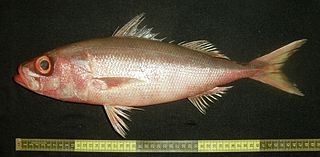
Emmelichthyidae is a small family of small to medium-sized marine ray-finned fishes known commonly as rovers, bonnetmouths or rubyfishes.

Emmelichthys nitidus, the Cape bonnetmouth, bonnetmouth, redbait, pearl fish, picarel, red baitfish, red herring or Southern rover, is a species of marine ray-finned fish belonging to the family Emmelichthyidae, the rovers and bonnetmouths. This species is found in the Indian and Pacific oceans. This species is of minor importance to commercial fisheries.

The rubyfish, also known as the cosmopolitan rubyfish, red ruby or ruby rover, is a species of marine ray-finned fish, belonging to the family Emmelichthyidae, the rovers, bonnetmouths and rubyfishes. This species is found from the southeastern Atlantic Ocean off South Africa through the Indian Ocean to the southwestern Pacific Ocean around Australia and New Zealand. This species is commercially important.

Argyrosomus is a genus of marine ray-finned fishes belonging to the family Sciaenidae, the drums. The fish in this genus are large and are commonly targeted as game fish.
Phenacoscorpius, the no-lined scorpionfishes, is a genus of marine ray-finned fish belonging to the family Scorpaenidae, the scorpionfishes. They are native to the western Atlantic, Pacific and Indian oceans.

Micropogonias is a genus of marine ray-finned fishes belonging to the family Sciaenidae, the drums and croakers. These fishes are found in the eastern Pacific and western Atlantic Oceans.

Variola, the lyretails, is a genus of marine ray-finned fish, groupers from the subfamily Epinephelinae, part of the family Serranidae, which also includes the anthias and sea basses. They are found in the tropical Indo-Pacific and their distribution extends from the Red Sea to South Africa across the Indian Ocean and east to the islands of the central Pacific.

Harpagifer, the spiny plunderfishes is a genus of marine ray-finned fishes, belonging to the family Harpagiferidae, it is the only genus in this monotypic family. They are found in the Southern Ocean.

Dicentrarchus is a genus of ray-finned fishes belonging to the family Moronidae, the temperate basses. The two species in this genus are found in the eastern Atlantic Ocean and the Mediterranean Sea. The species in this genus are economically important food fishes.

Easchmeyer nexus is a species of marine ray-finned fish; it is the only species in the monotypic genus Eschmeyer and monogeneric family Eschmeyeridae. This fish is only known from the Pacific Ocean, near Fiji.

Emmelichthys is a genus of marine ray-finned fishes belonging to the family Emmelichthyidae, the rovers and bonnetmouths. The species in this genus are found in the Atlantic, Indian and Pacific Oceans.

Erythrocles is a genus of marine ray-finned fishes belonging to the family Emmelichthyidae, the rovers, bonnetmouths or rubyfishes. The fishes in this genus are found in the western Atlantic, Pacific and Indian Oceans.
Nototheniops is a genus of marine ray-finned fishes belonging to the family Nototheniidae, the notothens or cod icefishes. The species in this genus are native to the Southern Ocean.

Gvozdarus svetovidovi, the naked-head toothfish, is a species of marine ray-finned fish belonging to the family Nototheniidae, the notothens or cod icefishes. It is found in the Ross and Cooperation Seas, probably south of the Antarctic Polar Front from pelagic waters down to depths of 550 m (1,804 ft), though it is normally found in a pelagic environment.
The Atlantic rubyfish, also known as the crimson rover, is a species of marine ray-finned fish belonging to the family Emmelichthyidae, the rovers, bonnetmouths and rubyfishes. This fish is found in the eastern and western central Atlantic Ocean.

The Japanese rubyfish also known as the Pacific rover or dusky rover, is a species of marine ray-finned fish belonging to the family Emmelichthyidae, the rovers, bonnetmouths and rubyfishes. This fish is found in the Indian and western Pacific Oceans.

Johnius dussumieri, the sin croaker, Dussumier's croaker, Dussumier's silver jewfish, sharptooth hammer croaker or whiskered croaker, is a marine ray-finned fish belonging to the family Sciaenidae, the drums and croakers. This fish is found in the Indian Ocean.

Johnius carutta, the karut croaker or purple jewfish, is a species of marine ray-finned fish belonging to the family Sciaenidae, the drums and croakers. This species is found in the western Indian Ocean.

The cuja bola is a species of marine ray-finned fish belonging to the family Sciaenidae, the drums and croakers. This fish is found in the northern Indian Ocean in India, Bangladesh, Myanmar and Thailand. It is the only species in the monospecific genus Macrospinosa.

The half-mourning croaker is a species of marine ray-finned fish belonging to the family Sciaenidae, the drums and croakers. It is the only species in the monospecific genus Paranibea. This fish is found in the Indo-Pacific region.
















